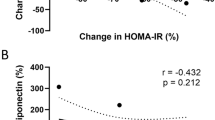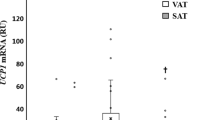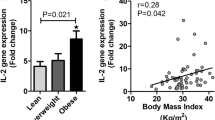Abstract
BACKGROUND: The human adiponectin gene has been implicated in the pathophysiology of obesity, type II diabetes mellitus, dyslipidemia and atherosclerosis. Investigation of the physiological functions of the adiponectin gene in humans was mainly conducted at the levels of plasma proteins or DNA polymorphisms. The depot-specific adiponectin mRNA levels also could be relevant to these physiological functions.
OBJECTIVES: The relation between the adipose depot-specific adiponectin mRNA expression levels and various metabolic factors, including BMI, fasting plasma glucose, insulin, triglycerides (TGs) and HDL-cholesterol and insulin resistance index by HOMA, was investigated among 66 nondiabetic women using quantitative real-time PCR.
RESULTS: The subcutaneous relative adiponectin mRNA levels (SRAmR) correlated significantly with the omental relative adiponectin mRNA levels (ORAmR) (γ=0.468, P=0.0001). The SRAmR correlated inversely with the fasting plasma glucose with a borderline significance (γ=−0.35, P=0.058). On the other hand, the ORAmR correlated negatively with serum TG levels with the adjustment for age (γ=−0.33, P=0.007) or age plus BMI (γ=−0.27, P=0.027).
CONCLUSION: These results indicate that the adiponectin mRNA levels in different adipose depots were at least related to certain phenotypes of metabolic syndrome. The expression levels of adiponectin in the omental adipose depots are related to TG metabolism.
This is a preview of subscription content, access via your institution
Access options
Subscribe to this journal
Receive 12 print issues and online access
$259.00 per year
only $21.58 per issue
Buy this article
- Purchase on Springer Link
- Instant access to full article PDF
Prices may be subject to local taxes which are calculated during checkout

Similar content being viewed by others
References
Fruhbeck G, Gomez-Ambrosi J, Muruzabal FJ, Burrell MA . The adipocyte: a model for integration of endocrine and metabolic signaling in energy metabolism regulation. Am J Physiol Endocrinol Metab 2000; 280: E827–E847.
Havel PJ . Control of energy homeostasis and insulin action by adipocyte hormones: leptin, acylation stimulating protein, and adiponectin. Curr Opin Lipidol 2002; 13: 51–59.
Zhou YT, Wang ZW, Higa M, Newgard CB, Unger RH . Reversing adipocyte differentiation: implications for treatment of obesity. Proc Natl Acad Sci USA 1999; 96: 2391–2395.
Harris RB . Leptin-much more than a satiety signal. Annu Rev Nutr 2000; 20: 45–75.
Arita Y, Kihara S, Ouchi N, Takahashi M, Maeda K, Miyagawa J, Hotta K, Shimomura I, Nakamura T, Miyaoka K, Kuriyama H, Nishida M, Yamashita S, Okubo K, Matsubara K, Muraguchi M, Ohmoto Y, Funahashi T, Matsuzawa Y . Paradoxical decrease of an adipose-specific protein, adiponectin, in obesity. Biochem Biophys Res Commun 1999; 257: 79–83.
Hotta K, Funahashi T, Arita Y, Takahashi M, Matsuda M, Okamoto Y, Iwahashi H, Kuriyama H, Ouchi N, Maeda K, Nishida M, Kihara S, Sakai N, Nakajima T, Hasegawa K, Muraguchi M, Ohmoto Y, Nakamura T, Yamashita S, Hanafusa T, Matsuzawa Y . Plasma concentrations of a novel, adipose-specific protein, adiponectin, in type 2 diabetic patients. Arterioscler Thromb Vasc Biol 2000; 20: 1595–1599.
Ouchi N, Kihara S, Arita Y, Maeda K, Kuriyama H, Okamoto Y, Hotta K, Nishida M, Takahashi M, Nakamura T, Yamashita S, Funahashi T, Matsuzawa Y . Novel modulator for endothelial adhesion molecules: adipocyte-derived plasma protein adiponectin. Circulation 1999; 100: 2473–2476.
Weyer C, Funahashi T, Tanaka S, Hotta K, Matsuzawa Y, Pratley RE, Tataranni PA . Hypoadiponectinemia in obesity and type 2 diabetes: close association with insulin resistance and hyperinsulinemia. J Clin Endocrinol Metab 2001; 86: 1930–1935.
Hara K, Boutin P, Mori Y, Tobe K, Dina C, Yasuda K, Yamauchi T, Otabe S, Okada T, Eto K, Kadowaki H, Hagura R, Akanuma Y, Yazaki Y, Nagai R, Taniyama M, Matsubara K, Yoda M, Nakano Y, Kimura S, Tomita M, Kimura S, Ito C, Froguel P, Kadowaki T . Genetic variation in the gene encoding adiponectin is associated with an increased risk of type 2 diabetes in the Japanese population. Diabetes 2002; 51: 536–540.
Stumvoll M, Tschritter O, Fritsche A, Staiger H, Renn W, Weisser M, Machicao F, Haring H . Association of the T-G polymorphism in adiponectin (exon 2) with obesity and insulin sensitivity: interaction with family history of type 2 diabetes. Diabetes 2002; 51: 37–41.
Kondo H, Shimomura I, Matsukawa Y, Kumada M, Takahashi M, Matsuda M, Ouchi N, Kihara S, Kawamoto T, Sumitsuji S, Funahashi T, Matsuzawa Y . Association of adiponectin mutation with type 2 diabetes: a candidate gene for the insulin resistance syndrome. Diabetes 2002; 51: 2325–2328.
Menzaghi C, Ercolino T, Di Paola R, Berg AH, Warram JH, Scherer PE, Trischitta V, Doria A . A haplotype at the adiponectin locus is associated with obesity and other features of the insulin resistance syndrome. Diabetes 2002; 51: 2306–2312.
Vasseur F, Helbecque N, Dina C, Lobbens S, Delannoy V, Gaget S, Boutin P, Vaxillaire M, Lepretre F, Dupont S, Hara K, Clement K, Bihain B, Kadowaki T, Froguel P . Single-nucleotide polymorphism haplotypes in the both proximal promoter and exon 3 of the APM1 gene modulate adipocyte-secreted adiponectin hormone levels and contribute to the genetic risk for type 2 diabetes in French Caucasians. Hum Mol Genet 2002; 11: 2607–2614.
Hu E, Liang P, Spiegelman BM . AdipoQ is a novel adipocyte-specific gene dysregulated in obesity. J Biol Chem 1996;271: 10697–10703.
Statnick MA, Beavers LS, Conner LJ, Corominola H, Johnson D, Hammond CD, Rafaeloff-Phail R, Seng T, Suter TM, Sluka JP, Ravussin E, Gadski RA, Caro JF . Decreased expression of apM1 in omental and subcutaneous adipose tissue of humans with type 2 diabetes. Int J Exp Diabetes Res 2000; 1: 81–88.
Lihn AS, Ostergard T, Nyholm B, Pedersen SB, Richelsen B, Schmitz O . Adiponectin mRNA expression in subcutaneous adipose tissue is reduced in first-degree relatives of type 2 diabetic patients. Am J Physiol Endocrinol Metab 2002; 284: E443–E448.
Yang WS, Lee WJ, Funahashi T, Tanaka S, Matsuzawa Y, Chao CL, Chen CL, Tai TY, Chuang LM . Weight reduction increases plasma levels of an adipose-derived anti-inflammatory protein, adiponectin. J Clin Endocrinol Metab 2001; 86: 3815–3819.
World Health Organization. The Asia-Pacific perspective: redefining obesity and its treatment. WHO: Geneva; 2000.
Huang KC, Chuang LM, Chen CY, Chow SN, Lin RS . Serum leptin and leptin receptor isoforms in omental adipose tissue of nondiabetic women undergoing gynecologic surgery for benign disease. J Formos Med Assoc 2000; 99: 839–843.
Fruebis J, Tsao TS, Javorschi S, Ebbets-Reed D, Erickson MR, Yen FT, Bihain BE, Lodish HF . Proteolytic cleavage product of 30-kDa adipocyte complement-related protein increases fatty acid oxidation in muscle and causes weight loss in mice. Proc Natl Acad Sci USA 2001; 98: 2005–2010.
Yamauchi T, Kamon J, Minokoshi Y, Ito Y, Waki H, Uchida S, Yamashita S, Noda M, Kita S, Ueki K, Eto K, Akanuma Y, Froguel P, Foufelle F, Ferre P, Carling D, Kimura S, Nagai R, Kahn BB, Kadowaki T . Adiponectin stimulates glucose utilization and fatty-acid oxidation by activating AMP-activated protein kinase. Nat Med 2002; 8: 1288–1295.
Scherer PE, Williams S, Fogliano M, Baldini G, Lodish HF . A novel serum protein similar to C1q, produced exclusively in adipocytes. J Biol Chem 1995; 270: 26746–26749.
Acknowledgements
We thank Ms Jao-Ping Wang for her technical assistance. This work was supported in part by a grant from the Ministry of Education (89-B-FA01-1-4) of Taiwan.
Author information
Authors and Affiliations
Corresponding author
Rights and permissions
About this article
Cite this article
Yang, WS., Chen, MH., Lee, WJ. et al. Adiponectin mRNA levels in the abdominal adipose depots of nondiabetic women. Int J Obes 27, 896–900 (2003). https://doi.org/10.1038/sj.ijo.0802367
Received:
Revised:
Accepted:
Published:
Issue Date:
DOI: https://doi.org/10.1038/sj.ijo.0802367
Keywords
This article is cited by
-
Ethnic Variations in Adiponectin Levels and Its Association with Age, Gender, Body Composition and Diet: Differences Between Iranians, Indians and Europeans Living in Australia
Journal of Immigrant and Minority Health (2018)
-
Morbidly “Healthy” Obese Are Not Metabolically Healthy but Less Metabolically Imbalanced Than Those with Type 2 Diabetes or Dyslipidemia
Obesity Surgery (2015)
-
Adiponectin mRNA in adipose tissue and its association with metabolic risk factors in postmenopausal obese women
Hormones (2013)
-
Adiponectin expression and metabolic markers in obesity and Type 2 diabetes
Journal of Endocrinological Investigation (2011)
-
Downregulation of ADIPOQ and PPARγ2 Gene Expression in Subcutaneous Adipose Tissue of Obese Adolescents With Hepatic Steatosis
Obesity (2010)



